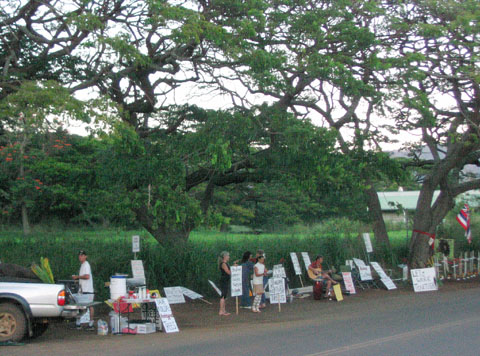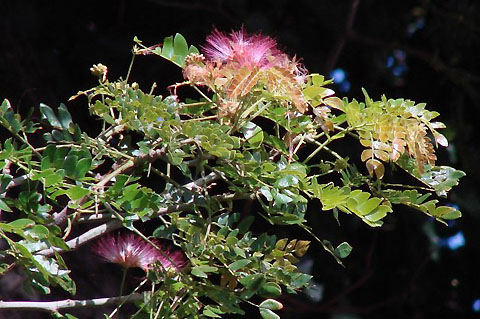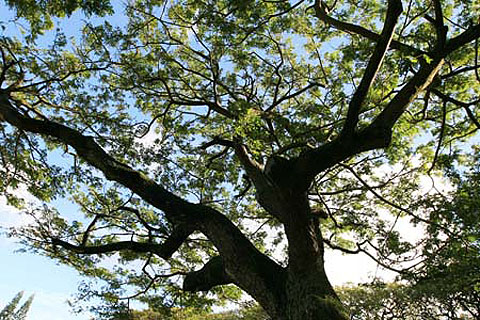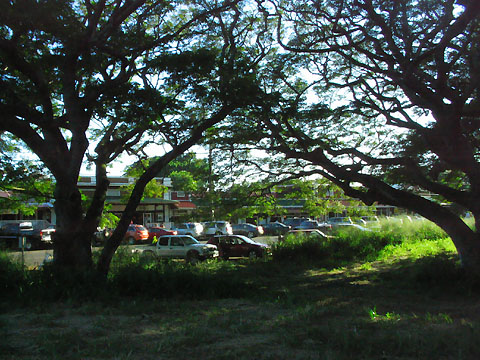Birds
and Plants of Kauai:
The Monkeypod Tree
by Linda Pascatore on 10 January 2008
During a recent vigil at the tree site, Poni Kamauu gave
this chant to the Monkeypod Trees in Old Koloa Town:
The
“Ohai” Trees (monkeypods)
Guardians that remain unmoved
Watching the winds from above
My “lei” of “ohia” (monkeypod) blossoms
came from the sea
to be a plaything for Kalo’a (The child’s name
is Kalo’a)
The Sea the creator of Life.
He kia’a o ka ‘ane’ene’e
He na-na o Makani no Luna
Ku’u lei ‘ohai alo ‘ehu kai
He hoa ka’ana
Aloha--Poni Kamauu
Beginning
in late 2007 and currently in early 2008, there has been
an ongoing demonstration to save the Monkeypod Trees in
Old Koloa Town. There is a development planned which calls
for the cutting of many of these old trees to built a shopping
center and parking lot. Although alternate plans that will
preserve the trees have been proposed, so far the developer
has not agreed to change their plans.
To contact the developer:
David Nelson
Nelson Companies Inc.
6960 Orchard Lake Road #200
West Bloomfield, MI 48322
(248) 539-9020
|

image
above:Candlelight Vigil to save the Monkeypods. Photo by Juan Wilson
The Monkeypod Tree, Samanea saman, is an alien tree to the Hawaiian
Islands. It originated in Central and SouthAmerica, but is now common
throughout the tropics as a shade tree. The scientific name, Pithecellobium,
means “monkey earring” in Greek, thus the name Monkeypod.
It is also called the Saman in Latin America, the Mimosa in the
Philippines, and also referred to as the Rain Tree. In Hawaii, it
is sometimes referred to as the Ohai tree, but is not to be confused
with an endemic woody shrub which is also called ‘Ohai.
Two Monkeypod seeds were brought to Hawaii in 1847 by a businessman,
Peter Brinsmade, who had passed through Panama on the way here.
One seedling was planted in downtown Honolulu, and the other in
Koloa on Kauai. These two trees are thought to be the progenitors
of all the trees in the state. Therefore the trees in old Koloa
town may have descended from the first Monkeypod tree, the grandmother
of all the trees on Kauai.
The Monkeypod is a large tree that provides a beautiful canopy of
shade. It is commonly found on lawns, gardens and public parks in
Hawaii. It also grows wild in old pastures and fields. The tree
can grow to 80 feet tall. It is in the legume family, and is a broad,
flat-topped tree which has twice compound dark green leaves, paired
leaves that fold up in the dark and open with the light. This allows
rain to fall through the canopy, so that the grass under a monkeypod
stays green even in time of drought.

The flowers are clusters of pink stamens, which look like powderpuffs
in the tree tops. The sticky, dark brown seed pods are 6-8 inches
long. Reddish brown seeds are normally carried by birds or rodents,
and germinate quickly and easily. However, long term survival of
the seedlings is more difficult, as they require sunlight and are
susceptible to herbicides.
The wood of the monkeypod is often used for carving, and commonly
seen as salad bowl sets sold to tourists here. The wood is easy
to work and doesn’t shrink much during drying, which means
it can be worked when green. Most of the Monkeypod used for woodworking
is now grown in Thailand or the Philippines rather than in Hawaii.
The pod has sweet pulp that can be used for animal feed. Pods can
also be chewed for a licorice-like flavor.
You can find Monkeypods all over Kauai, in many public venues. Enjoy
their majestic canopy and cool shade!
 image
above: Monkeypod tree canopy. Photo by Carol Ann Davis-Briant image
above: Monkeypod tree canopy. Photo by Carol Ann Davis-Briant
|





 image
above: Monkeypod tree canopy. Photo by Carol Ann Davis-Briant
image
above: Monkeypod tree canopy. Photo by Carol Ann Davis-Briant